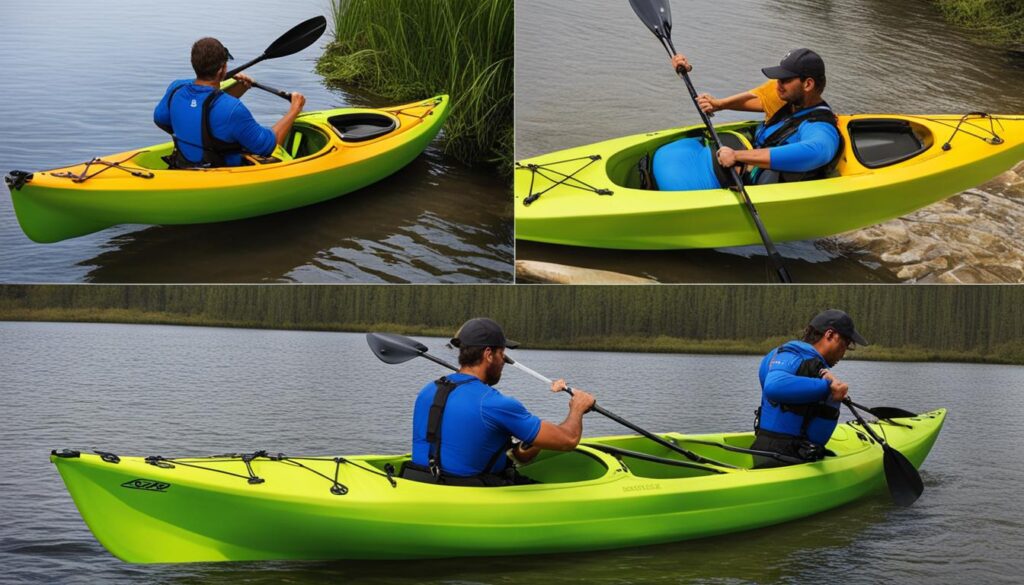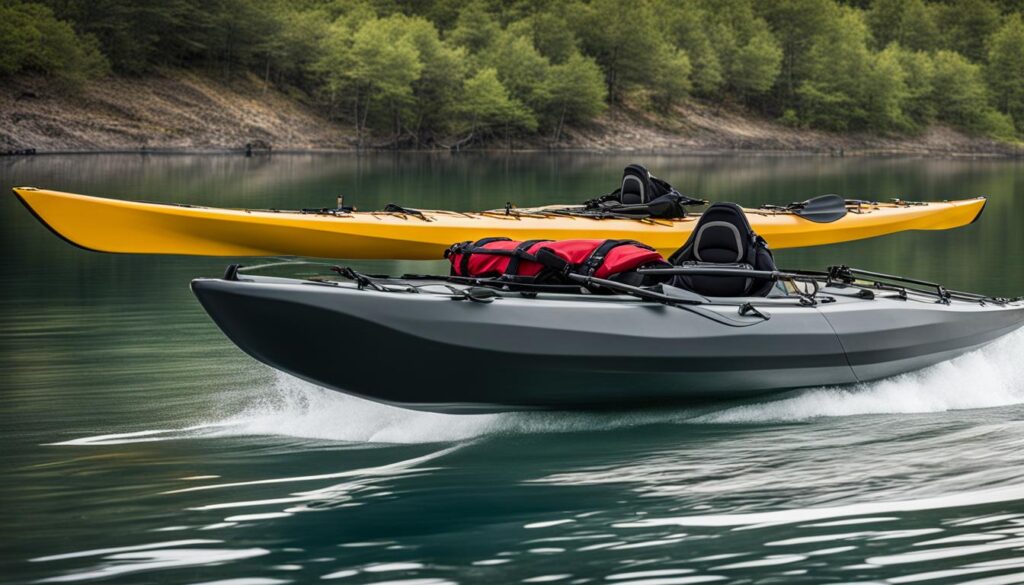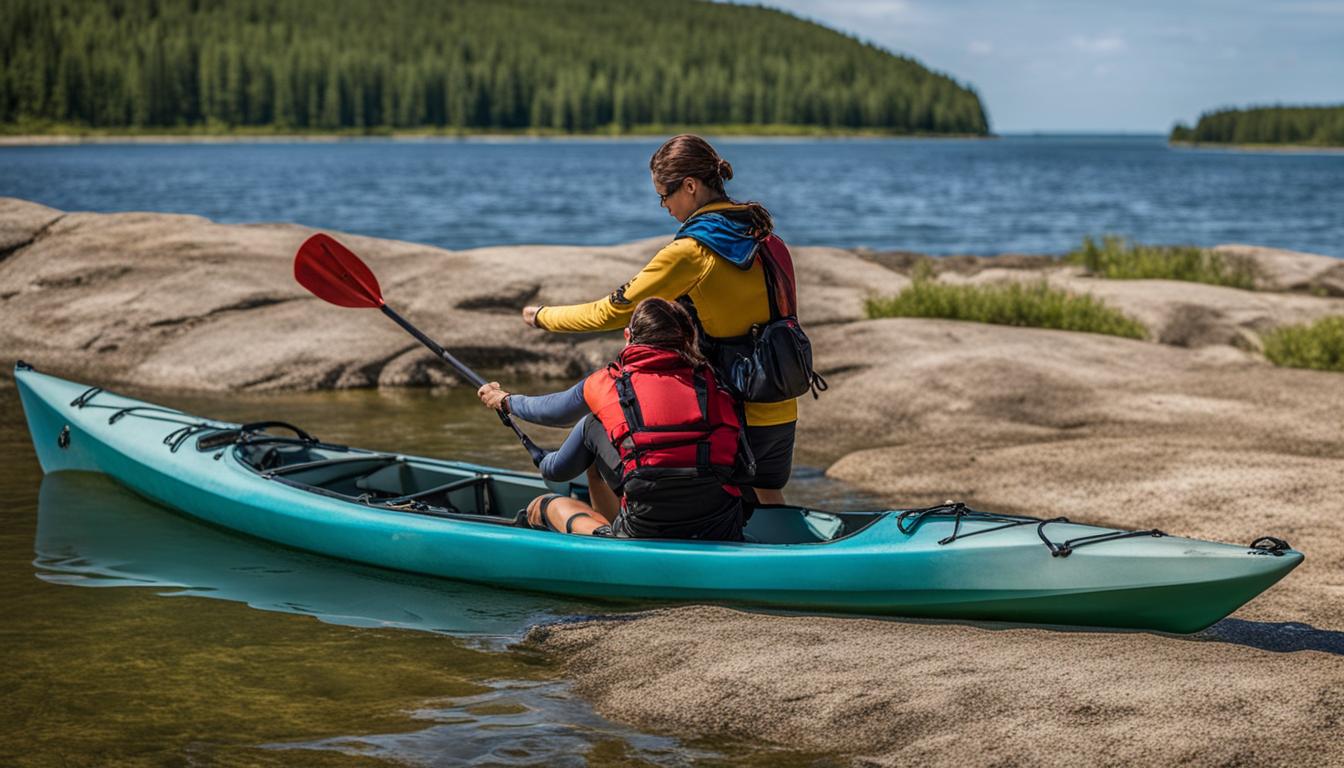Lifting, loading, and carrying a kayak can be challenging, especially if it is heavy. However, with the right techniques, you can lift heavy kayaks safely and efficiently. It is important to use proper lifting techniques, such as bending at the knees and not at the waist, when lifting a kayak to protect your back. Additionally, utilizing ergonomic lifting methods and equipment, such as kayak carts or trolleys, can make the process easier on your body and help prevent injuries. By following these techniques, you can effectively lift heavy kayaks without straining yourself.
Key Takeaways:
- Use proper lifting techniques, such as bending at the knees, to protect your back when lifting heavy kayaks.
- Utilize ergonomic lifting methods and equipment, such as kayak carts or trolleys, for easier and safer transportation.
- Consider using roof racks to securely load and transport heavy kayaks on your vehicle.
- Use cam straps to properly tie down your kayak for secure transportation.
- By following these techniques and using the right equipment, you can safely lift and transport heavy kayaks, enjoying your kayaking adventures without strain or risk of damage.
Proper Technique for Lifting and Carrying Kayaks
Lifting and carrying a kayak, especially a heavy one, requires proper technique to avoid strain and ensure efficiency. Here are some tips for handling large kayaks and methods for lifting bulky kayaks:
1. Start with the Right Position
Stand with the kayak on the ground on its edge against your shins, with the cockpit facing out. This position gives you better control and leverage when lifting.
2. Bend Your Knees and Slide onto Your Thighs
Bend your knees and place both hands on the edge of the cockpit closest to your chest. Slide the kayak up onto your thighs while keeping your knees bent. This technique distributes the weight and reduces strain on your back.
3. Grasp the Opposite Side of the Cockpit Rim
Once the kayak is resting on your thighs, reach over and grasp the opposite side of the cockpit rim with your hand. This grip provides stability and balance when lifting.
4. Lift and Carry onto Your Shoulder
As you stand up, lift the right side of the cockpit rim up and onto your shoulder. Make sure the kayak feels balanced and walk without the boat hitting the ground at either end. Utilizing this method, you can effectively handle larger and bulkier kayaks with ease.
Remember to always prioritize your safety and use caution when lifting heavy kayaks. By following these proper techniques, you can prevent injuries and enjoy your kayaking adventures to the fullest!

| Key Benefits | Challenges |
|---|---|
| Improves safety and prevents injuries | Requires proper form and practice |
| Reduces strain on the back and body | May be more difficult with very heavy kayaks |
| Enables efficient and controlled lifting | Requires physical strength and endurance |
| Allows for easier transportation and storage | May take time to master the technique |
Tips for Easy Transportation of Heavy Kayaks
Transporting heavy kayaks can be a challenging task, but with the right tips and techniques, you can make it easier and more efficient. Whether you’re moving your kayak from your vehicle to the water or navigating different terrains, here are some solutions to ensure a smooth transportation experience.
Use a Kayak Cart
A kayak cart or trolley is a practical tool that can make transporting heavy kayaks a breeze. These two-wheeled attachments provide support and distribute the weight of the kayak, making it easier to wheel it along. Simply grab the handle at one end of the cart, similar to a wheelbarrow, and roll your kayak to your desired location. Kayak carts are particularly useful for longer distances or when navigating grassy shorelines or boat launches. However, they are not recommended for rough or rocky terrains.
Secure Your Kayak Properly
When transporting your kayak, it’s crucial to secure it properly to prevent any accidents or damage. Using cam straps is an easy and effective method to ensure a secure hold. These straps are simple to use and provide a tight grip, eliminating the need for complicated knots. Tighten the straps on either side of the widest part of your kayak to prevent any forward or backward movement during transportation. Additionally, consider using bow and stern lines for extra security. These lines can be attached to the front and back of your kayak, minimizing any warping or shifting during transit.
Roof Racks for Vehicle Transportation
If you’re transporting your kayak on your vehicle, investing in a good roof rack system is essential. Different types of roof racks, such as J-craddles and stackers, are available to securely hold your kayak in place. J-craddles hold the kayak on its side, freeing up space for additional storage on your roof. Stackers allow you to stack multiple kayaks on their sides, maximizing your carrying capacity. By following proper lifting techniques and using the right equipment, like roof racks, you can ensure a safe and efficient transportation process without causing any damage to your vehicle or kayak.
With these tips, you can confidently transport heavy kayaks without straining yourself or worrying about potential damage. Whether you opt for a kayak cart, secure your kayak with cam straps, or utilize roof racks, finding the right transportation solution will make your kayaking adventures more enjoyable and stress-free.
Loading a Kayak onto Your Vehicle with Roof Racks
Loading a kayak onto your vehicle can be challenging, especially if it is heavy. One of the best ways to handle heavy kayaks during transportation is by using roof racks. Roof racks provide a secure and stable platform for your kayak, ensuring it stays in place while you drive. There are different types of roof rack systems available, such as J-craddles and stackers, which allow you to safely secure your kayak on the roof of your vehicle.

J-craddles hold the kayak on its side, freeing up roof space for additional storage. They are especially useful for longer kayaks or when you need to transport multiple kayaks. To load a kayak onto J-craddles, start by positioning the kayak alongside your vehicle. Lift one end of the kayak onto the rear cradle, ensuring it is centered and stable. Then, lift the other end of the kayak onto the front cradle, making sure it is evenly balanced. Secure the kayak with straps or tie-downs to keep it in place.
Stackers, on the other hand, allow you to stack multiple kayaks on their sides. This is a great option if you need to transport more than one kayak at a time. To load kayaks onto stackers, position the first kayak on its side on the bottom rack. Then, carefully place the second kayak on top, ensuring they are aligned and balanced. Use straps or tie-downs to secure both kayaks to the stacker and your vehicle.
| Rack Type | Pros | Cons |
|---|---|---|
| J-craddles | – Frees up roof space | – May limit roof access for other gear |
| Stackers | – Allows for multi-kayak transport | – Requires careful alignment and balancing |
When loading a kayak onto your roof racks, it’s important to follow proper lifting techniques to avoid straining yourself. Lift with your legs, not your back, and have a second person help if needed. Ensure that the kayak is centered and secure on the racks before hitting the road. Additionally, always check the weight capacity of your roof racks and make sure they are properly installed to avoid any accidents during transportation.
Tying Down Your Kayak for Secure Transportation
After loading your kayak onto your vehicle, it’s crucial to secure it properly for safe and worry-free transportation. The best way to achieve this is by using cam straps. These straps are not only easy to use but also provide a secure hold, ensuring that your kayak stays in place during transit. To secure your kayak, follow these steps:
- Place the cam strap around the kayak and feed the loose end through the cam buckle.
- Tighten the strap by pulling the loose end firmly. The cam buckle will hold the strap in place, eliminating the need for any specific knots.
- Make sure to tighten the straps on either side of the widest part of the kayak. This will prevent any forward or backward movement during transportation.
- For additional security, consider using bow and stern lines. These lines can be attached to the front and back of your kayak, helping to prevent any warping of the boat along its length.
By properly tying down your kayak with cam straps and utilizing bow and stern lines, you can have peace of mind knowing that your kayak is securely fastened to your vehicle.
“Properly securing your kayak is crucial for safe transportation. Always ensure that your straps are tight and secure before hitting the road. Taking a few extra minutes to properly tie down your kayak can save you from potential accidents and damage to your equipment.”
Whether you’re heading to a nearby lake or embarking on a long road trip, secure transportation is essential for heavy kayaks. By following the tips and techniques in this section, you can transport your kayak safely, without any risk of damage. Now that you know how to tie down your kayak, you’re ready to hit the road and enjoy your kayaking adventures!
| Strap Type | Pros | Cons |
|---|---|---|
| Cam Straps | Secure hold, easy to use, no need for specific knots | May require additional bow and stern lines for extra security |
| Ratchet Straps | Can provide even stronger tension, good for larger kayaks | More complicated to use, may require specific knots |
| Bungee Cords | Flexible and easy to use for lighter kayaks | May not provide enough tension for heavy kayaks |
Conclusion
Handling and transporting heavy kayaks doesn’t have to be a daunting task. By utilizing the right techniques and equipment, you can ensure the safety and efficiency of your kayak lifting and transportation process.
First and foremost, it’s crucial to employ proper lifting techniques. Always remember to bend at the knees, not at the waist, when lifting a heavy kayak. This helps protect your back and prevent any potential injuries. Additionally, consider using ergonomic lifting methods, such as kayak carts or trolleys, which can greatly alleviate the strain on your body.
When it comes to transportation, roof racks are a fantastic solution for securely loading your kayak onto your vehicle. There are various types of roof rack systems available, each with its own advantages. J-craddles and stackers offer safe and efficient ways to transport heavy kayaks, ensuring no damage is caused to your vehicle or kayak.
Once your kayak is properly loaded, don’t forget to secure it tightly using cam straps. These reliable straps provide a strong hold and are easy to use, minimizing any movement during transportation. Consider using bow and stern lines for added security, preventing any potential warping of your kayak.
By implementing these heavy kayak lifting techniques and solutions for handling and transporting your kayak, you can enjoy your kayaking adventures with peace of mind, knowing that both you and your equipment are well taken care of.
FAQ
What are the best techniques for lifting heavy kayaks safely and efficiently?
The best techniques for lifting heavy kayaks include bending at the knees and not at the waist, using ergonomic lifting methods, and utilizing equipment such as kayak carts or trolleys.
How do I lift and carry a shorter, lighter kayak?
To lift and carry a shorter, lighter kayak, start by standing with the kayak on the ground on edge against your shins. Bend your knees, place both hands on the edge of the cockpit closest to your chest, and slide the kayak up onto your thighs while keeping your knees bent. Once the kayak is resting on your thighs, grasp the opposite side of the cockpit rim with your hand. As you stand up, lift the right side of the cockpit rim up and onto your shoulder.
What are kayak carts or trolleys and how do they help with heavy kayak transportation?
Kayak carts or trolleys are two-wheeled attachments that allow you to wheel your kayak along by grabbing a handle at one end. They provide support and help distribute the weight of the kayak, making it easier to transport. Kayak carts can be folded or assembled/disassembled easily, making them convenient for storage while you paddle.
What is the best way to load a heavy kayak onto my vehicle?
One of the best ways to load a heavy kayak onto your vehicle is by using roof racks. There are different types of roof rack systems available, such as J-craddles and stackers, which allow you to safely secure your kayak on the roof of your vehicle.
How do I properly secure my kayak to my vehicle for safe transportation?
To properly secure your kayak to your vehicle, use cam straps. Cam straps provide a secure hold and are easy to use. Make sure to tighten the straps on either side of the widest part of the kayak to prevent any forward or backward movement. Consider using bow and stern lines for extra security.





